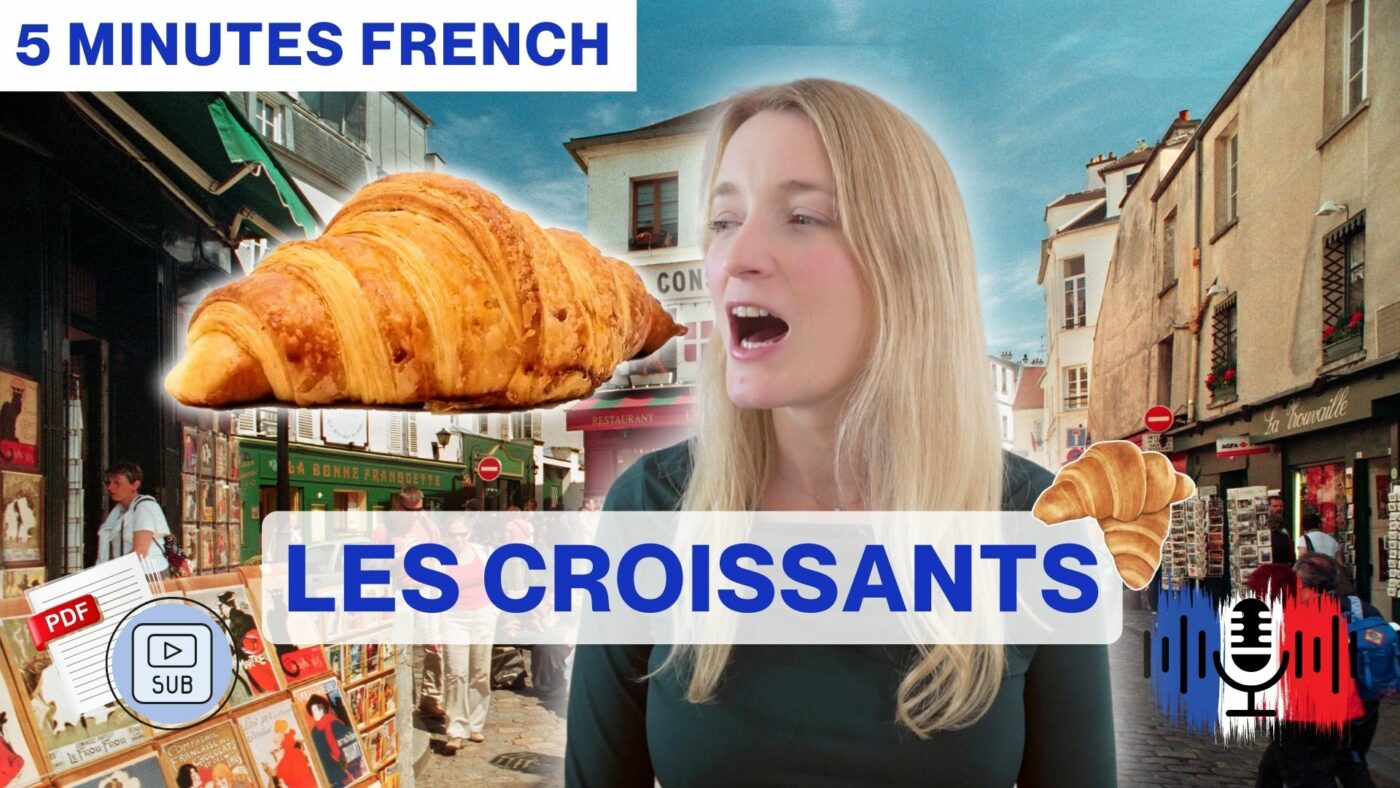
Menu
Close
French story: Le croissant, for beginners/intermediates comes from my second YouTube channel French chit-chat with Dylane. You can find the story in English and French. Watch the video to work on your listening skills, you can even turn on the subtitles in French or in English.

Le croissant, c’est une viennoiserie délicieuse qui fait partie de la culture française. Mais est-ce que vous savez que le croissant n’a techniquement pas été inventé en France ?
L’origine du croissant remonte à 1683 à Vienne, en Autriche. Pendant que les Turcs assiègent Vienne tôt le matin, le boulanger Adam Spiel, qui était déjà au travail, donne l’alerte au moment d’une attaque ottomane qui permet de repousser l’envahisseur. Pour célébrer cette victoire, de petits croissants sont confectionnés par les boulangers de la ville, rappelant ainsi la forme du symbole ottoman. Le nom de ce petit croissant est le kipferl.
Le croissant comme on le connaît en France et partout dans le monde, est aujourd’hui différent du croissant autrichien. Le kipferl est fait de pâte briochée, alors que le croissant est fait de pâte feuilletée. On estime que le changement de pâte s’est produit au 20ème siècle et que le premier croissant a été vendu en France en 1920.
Ça c’est pour l’origine du croissant. Maintenant parlons de ses ingrédients et de chiffres.
Faire des croissants soi-même, cela prend du temps et pas mal d’ingrédients. Pour faire des croissants il faut :
– De la farine
– Du sucre
– Du lait
– Du beurre
– Du sel
– De la levure
– Des œufs
Avant de continuer, je dois dire que les diététiciens recommandent de consommer les croissants avec modération car ils ont un taux important de matière grasse. 20% pour être exacte.
Les ingrédients sont mélangés ensemble pour former une pâte qui doit reposer plusieurs fois entre les étapes. La pâte feuilletée est une pâte qui est pliée plusieurs fois sur elle-même pour obtenir le feuilletage. Vous pouvez voir toutes “les feuilles” si vous coupez un croissant. La pâte est la même pour les pains au chocolat.
Les croissants peuvent avoir différentes saveurs ou ils peuvent être nature. Nature, c’est juste le croissant. Ils peuvent être fourrés aux amandes, au chocolat, à la vanille, et bien plus.
Je pense que vous le savez déjà mais le croissant est la viennoiserie préférée des Français, juste devant le pain au chocolat. Il est consommé par 3 français sur 4.
Au niveau du prix, un croissant coûte entre 1 et 2 euros.
La plupart des gens mangent des croissants le matin avec une boisson chaude, souvent un café.
Presque 2 milliards de croissants sont consommés chaque année en France.
La plupart des croissants sont achetés à la boulangerie ou dans les supermarchés.
Certaines boulangeries utilisent des odeurs artificielles pour vous faire acheter des croissants. Les croissants sont souvent faits le matin mais vous pouvez sentir l’odeur de cuisson devant certaines boulangeries toute la journée. Dans ce cas, c’est souvent artificiel.
Alors dites-moi, est-ce que vous avez déjà goûté un croissant et est-ce que vous trouvez ça bon ? Si oui, est-ce que vous en mangez souvent ? Dites-moi tout en commentaires.
The croissant is a delicious pastry that is part of French culture. But did you know that the croissant was technically not invented in France?
The origin of the croissant dates back to 1683 in Vienna, Austria. While the Turks were besieging Vienna early in the morning, the baker Adam Spiel, who was already at work, sounded the alarm at the moment of an Ottoman attack, which helped repel the invader. To celebrate this victory, small crescent-shaped pastries were made by the city’s bakers, thus recalling the shape of the Ottoman symbol. The name of this little croissant is “kipferl.”
The croissant as we know it in France and around the world is different from the Austrian croissant. The kipferl is made of brioche dough, while the croissant is made of puff pastry. It is estimated that the change in dough occurred in the 20th century, and the first croissant was sold in France in 1920.
That’s the origin of the croissant. Now let’s talk about its ingredients and numbers.
Making croissants yourself takes time and quite a few ingredients. To make croissants, you need:
Flour
Sugar
Milk
Butter
Salt
Yeast
Eggs
Before continuing, I must say that dieticians recommend consuming croissants in moderation because they have a high fat content, 20% to be exact.
The ingredients are mixed together to form a dough that needs to rest several times between the steps. Puff pastry is a dough that is folded several times on itself to achieve the flakiness. You can see all the “layers” if you cut a croissant. The dough is the same for chocolate croissants.
Croissants can have different flavors, or they can be plain. Plain means just the croissant. They can be filled with almonds, chocolate, vanilla, and much more.
I think you already know, but the croissant is the favorite pastry of the French, just ahead of chocolate bread. It is consumed by 3 out of 4 French people.
In terms of price, a croissant costs between 1 and 2 euros.
Most people eat croissants in the morning with a hot drink, often coffee.
Almost 2 billion croissants are consumed each year in France.
Most croissants are bought at bakeries or supermarkets.
Some bakeries use artificial scents to make you buy croissants. Croissants are often made in the morning, but you can smell the baking odor in front of some bakeries all day. In this case, it’s often artificial.
So tell me, have you ever tasted a croissant, and do you find it good? If yes, do you eat it often? Tell me everything in the comments.
Check out my French Listening Practice Workshop to improve your French speaking skills.
